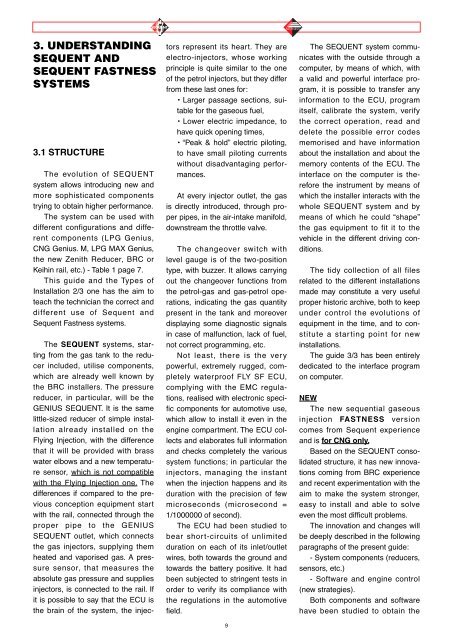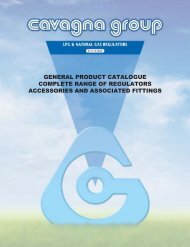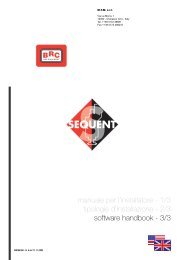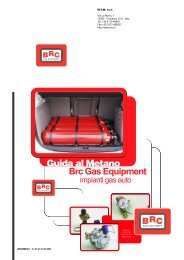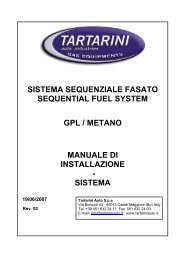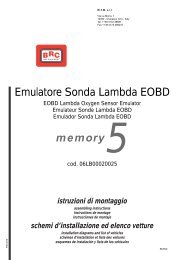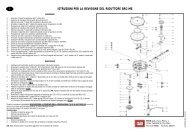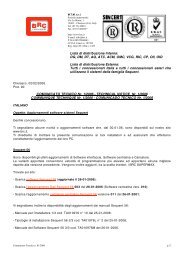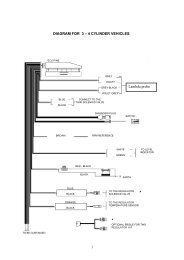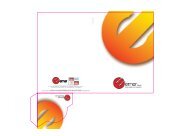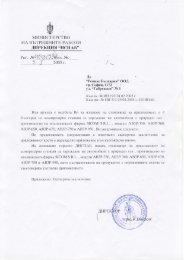Installer's handbook - 1/3 Types of installation - 2/3 Software guide ...
Installer's handbook - 1/3 Types of installation - 2/3 Software guide ...
Installer's handbook - 1/3 Types of installation - 2/3 Software guide ...
You also want an ePaper? Increase the reach of your titles
YUMPU automatically turns print PDFs into web optimized ePapers that Google loves.
3. UNDERSTANDING<br />
SEQUENT AND<br />
SEQUENT FASTNESS<br />
SYSTEMS<br />
3.1 STRUCTURE<br />
The evolution <strong>of</strong> SEQUENT<br />
system allows introducing new and<br />
more sophisticated components<br />
trying to obtain higher performance.<br />
The system can be used with<br />
different configurations and different<br />
components (LPG Genius,<br />
CNG Genius. M, LPG MAX Genius,<br />
the new Zenith Reducer, BRC or<br />
Keihin rail, etc.) - Table 1 page 7.<br />
This <strong>guide</strong> and the <strong>Types</strong> <strong>of</strong><br />
Installation 2/3 one has the aim to<br />
teach the technician the correct and<br />
different use <strong>of</strong> Sequent and<br />
Sequent Fastness systems.<br />
The SEQUENT systems, starting<br />
from the gas tank to the reducer<br />
included, utilise components,<br />
which are already well known by<br />
the BRC installers. The pressure<br />
reducer, in particular, will be the<br />
GENIUS SEQUENT. It is the same<br />
little-sized reducer <strong>of</strong> simple <strong>installation</strong><br />
already installed on the<br />
Flying Injection, with the difference<br />
that it will be provided with brass<br />
water elbows and a new temperature<br />
sensor, which is not compatible<br />
with the Flying Injection one. The<br />
differences if compared to the previous<br />
conception equipment start<br />
with the rail, connected through the<br />
proper pipe to the GENIUS<br />
SEQUENT outlet, which connects<br />
the gas injectors, supplying them<br />
heated and vaporised gas. A pressure<br />
sensor, that measures the<br />
absolute gas pressure and supplies<br />
injectors, is connected to the rail. If<br />
it is possible to say that the ECU is<br />
the brain <strong>of</strong> the system, the injec-<br />
tors represent its heart. They are<br />
electro-injectors, whose working<br />
principle is quite similar to the one<br />
<strong>of</strong> the petrol injectors, but they differ<br />
from these last ones for:<br />
• Larger passage sections, suitable<br />
for the gaseous fuel,<br />
• Lower electric impedance, to<br />
have quick opening times,<br />
• “Peak & hold” electric piloting,<br />
to have small piloting currents<br />
without disadvantaging performances.<br />
At every injector outlet, the gas<br />
is directly introduced, through proper<br />
pipes, in the air-intake manifold,<br />
downstream the throttle valve.<br />
The changeover switch with<br />
level gauge is <strong>of</strong> the two-position<br />
type, with buzzer. It allows carrying<br />
out the changeover functions from<br />
the petrol-gas and gas-petrol operations,<br />
indicating the gas quantity<br />
present in the tank and moreover<br />
displaying some diagnostic signals<br />
in case <strong>of</strong> malfunction, lack <strong>of</strong> fuel,<br />
not correct programming, etc.<br />
Not least, there is the very<br />
powerful, extremely rugged, completely<br />
waterpro<strong>of</strong> FLY SF ECU,<br />
complying with the EMC regulations,<br />
realised with electronic specific<br />
components for automotive use,<br />
which allow to install it even in the<br />
engine compartment. The ECU collects<br />
and elaborates full information<br />
and checks completely the various<br />
system functions; in particular the<br />
injectors, managing the instant<br />
when the injection happens and its<br />
duration with the precision <strong>of</strong> few<br />
microseconds (microsecond =<br />
1/1000000 <strong>of</strong> second).<br />
The ECU had been studied to<br />
bear short-circuits <strong>of</strong> unlimited<br />
duration on each <strong>of</strong> its inlet/outlet<br />
wires, both towards the ground and<br />
towards the battery positive. It had<br />
been subjected to stringent tests in<br />
order to verify its compliance with<br />
the regulations in the automotive<br />
field.<br />
9<br />
The SEQUENT system communicates<br />
with the outside through a<br />
computer, by means <strong>of</strong> which, with<br />
a valid and powerful interface program,<br />
it is possible to transfer any<br />
information to the ECU, program<br />
itself, calibrate the system, verify<br />
the correct operation, read and<br />
delete the possible error codes<br />
memorised and have information<br />
about the <strong>installation</strong> and about the<br />
memory contents <strong>of</strong> the ECU. The<br />
interface on the computer is therefore<br />
the instrument by means <strong>of</strong><br />
which the installer interacts with the<br />
whole SEQUENT system and by<br />
means <strong>of</strong> which he could “shape”<br />
the gas equipment to fit it to the<br />
vehicle in the different driving conditions.<br />
The tidy collection <strong>of</strong> all files<br />
related to the different <strong>installation</strong>s<br />
made may constitute a very useful<br />
proper historic archive, both to keep<br />
under control the evolutions <strong>of</strong><br />
equipment in the time, and to constitute<br />
a starting point for new<br />
<strong>installation</strong>s.<br />
The <strong>guide</strong> 3/3 has been entirely<br />
dedicated to the interface program<br />
on computer.<br />
NEW<br />
The new sequential gaseous<br />
injection FASTNESS version<br />
comes from Sequent experience<br />
and is for CNG only.<br />
Based on the SEQUENT consolidated<br />
structure, it has new innovations<br />
coming from BRC experience<br />
and recent experimentation with the<br />
aim to make the system stronger,<br />
easy to install and able to solve<br />
even the most difficult problems.<br />
The innovation and changes will<br />
be deeply described in the following<br />
paragraphs <strong>of</strong> the present <strong>guide</strong>:<br />
- System components (reducers,<br />
sensors, etc.)<br />
- S<strong>of</strong>tware and engine control<br />
(new strategies).<br />
Both components and s<strong>of</strong>tware<br />
have been studied to obtain the


